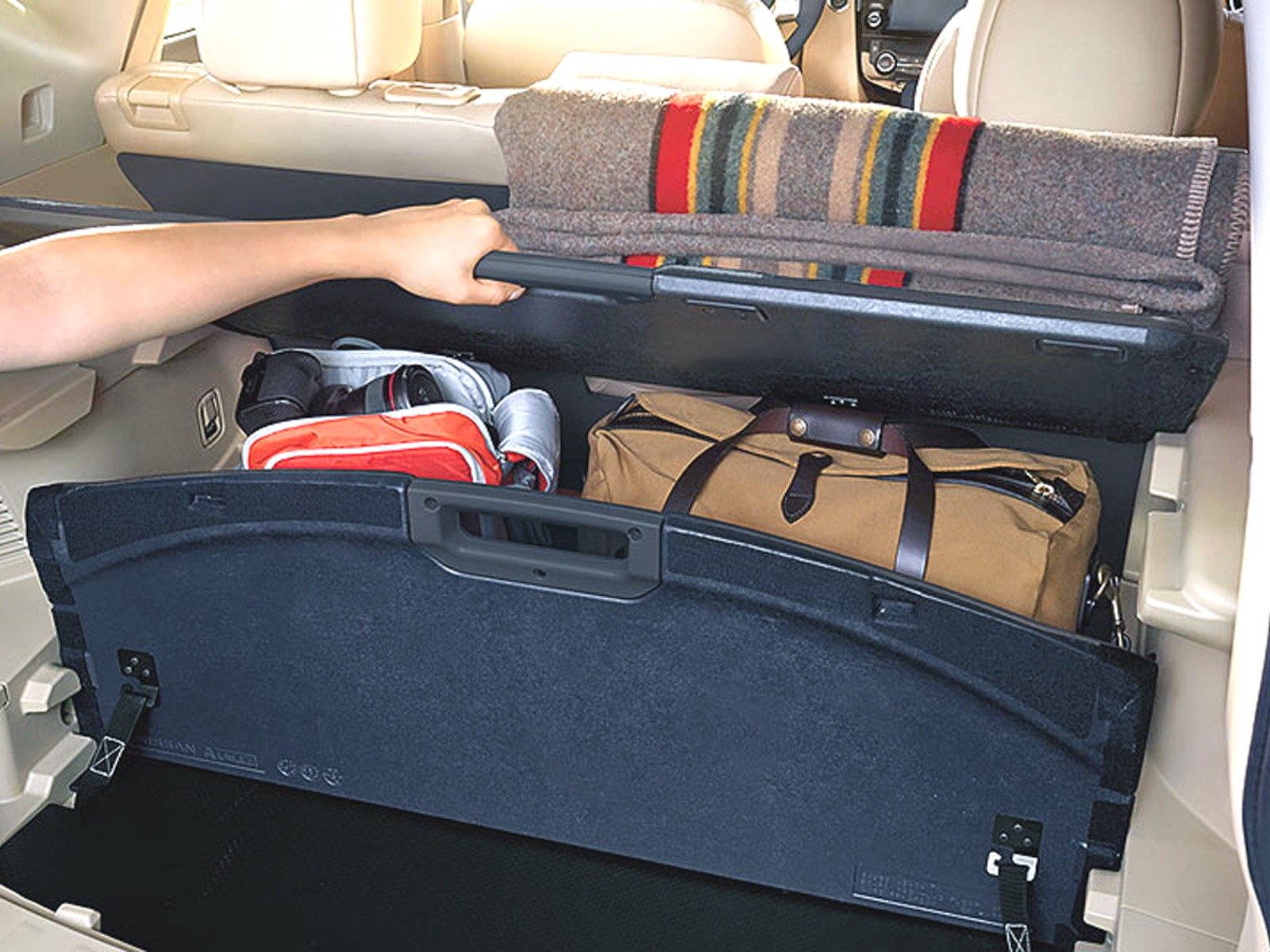This content is presented in partnership with ADAMM.
The ancient Zen master who came up with the idea that the journey was better than the destination probably never went on a long family car trip at the peak of summer. Fortunately for those of us living in the 21st century, cars have what it takes to make the journey very pleasant, indeed.
Air conditioning and cruise control are ubiquitous, and vehicles are safer and more reliable than ever. But for an extended, soul-restoring vacation, the modern family craves creature comforts – things like comfy seats, ample cargo space and the ability to stay connected or entertained even when you’re in the middle of nowhere.
Lots of vehicles deliver on all three, which means you have to figure out what you want most. To help you with that, local auto industry pros from Schlossmann's Honda City, Rosen Kia and Russ Darrow Nissan chimed in with their philosophies.
Infotainment is evolving
Many years ago, automakers started offering in-car entertainment options like DVD players and monitors that dropped from the ceiling or were embedded in front seat backs to attract parents with kids who were raised on screen time. But, used to smartphones and notepads, kids today seem to be moving away from built-in systems – and car companies seem to be following suit.
"It keeps getting easier to use Wi-Fi in cars, and as kids get older, they get more interested in their own devices and less interested in rear-seat DVD players and game consoles," says Schlossmann’s sales rep Thomas Cherr.
That said, Cherr’s store sells a vehicle, the Honda Odyssey minivan, that gets high marks from reviewers for its recent in-car infotainment upgrades.
"Unsurprisingly, minivan engineers know how to coddle the most discerning rear passengers better than anyone," writes Car and Driver contributor Clifford Atiyeh. "Not only do they pack the latest high-res inputs like Blu-ray and HDMI, but their screens can hide."
The Odyssey has a wide (10.2-inch) split-screen unit that swivels down from the roof. It also comes with built-in "child-friendly" apps, such as PBS Kids Video and HappyKids.TV, plus an are-we-there-yet animation in which a rocket ship shows how the trip is progressing.
CabinWatch and CabinTalk, also available on the Odyssey, are fun and practical. The driver and front passenger can use CabinWatch to monitor the second and third rows, while CabinTalk lets people in front communicate with people in back who are using headphones while watching the rear screen.
"It’s like piloting your own airplane," Atiyeh says. If that doesn’t sound like a blast, consider that CabinWatch also has infrared night vision.
Cherr says the built-in system is still popular with families. The screen, he says, comes to down the ideal level for second- and third-row passengers. Plus, it comes with a handheld remote control that anyone in the back rows can operate. The driver also has steering wheel controls to change the audio from what’s playing on the radio to what the rear-seat passengers are watching or listening to.
At the same time, Honda has makes it easy to switch to Apple CarPlay or Android Auto for phones and notepads.
Reviewers also give the Chrysler Pacifica’s built-in infotainment system high marks. It features separate screens for each second-row captain’s seat passenger that flip down and out of sight into the backs of the minivan’s front-row seats. Atiyeh also likes the games, which he calls "actually good," noting that back-seat passengers can play checkers against each other, count license plates, practice basic math skills and follow real-time progress updates from the navigation system.
Many manufacturers are focusing less on built-in entertainment and more on turning your vehicle into a Wi-Fi hotspot. To avoid chewing through data on your own plan, many manufacturers offer monthly subscriptions to Wi-Fi plans. Costs vary, but reviewers say such arrangements have become increasingly popular as plans expand to enable as many as eight devices at once.
Cargo space for material possessions abounds
It’s not always easy to travel light with a family, but intelligent design and the use of lighter materials that allow cars to have more interior space even as they weigh less have led to a long list of vehicles capable of dealing with baggage.
For example, US News lists six large SUVs that boast between 57 and 76 cubic feet of cargo space with the third row of seats folded down. Some of those vehicles, including the Ford Expedition Max, Cadillac Escalade ESV and largest versions of the GM Yukon and Chevrolet Suburban, have between 36 and 39 cubic feet of space behind the third row alone.
Of course, not everyone wants or needs the biggest vehicle during the 11 and a half months when they’re not on vacation, but a few smaller SUVs are quite generous with space. For example, the Nissan Rogue, which US News calls "the most popular and most versatile small SUV sold in America," has room for 39.3 cubic feet of cargo behind the rear seat – as much as you get with the biggest of the biggies.
The Rogue also comes with a secret compartment beneath the floor. The Divide-N-Hide "cargo management system" allows you to create shelves and cubbies to organize stuff and keep it out of sight.
"You can use that for anything," says Rob Garcia, Darrow Nissan’s sales manager. "It’s really great for smaller stuff that you don’t want rolling around, like golf balls or tennis balls."
Interior designers at Chevrolet used a different strategy with the Traverse three-row SUV by augmenting its 23 cubic feet of space behind the third row with "several small cargo cubbies throughout the cabin to keep small items from getting lost."
When shopping for a vehicle, reviewers suggest making sure you’re comfortable with the height of a vehicle’s cargo area and whether you like how cargo-space entry works. Many vehicles now have hatches that can be opened by waving a foot under the rear bumper. A Volvo XC90, when equipped with air suspension, even lets you lower the height of the cargo floor for easy loading.
While they generally offer less cargo room than SUVs and vans, some sedans offer 16 to 20 cubic feet of trunk space. According to US News, the Ford Taurus "is the best among large sedans with a whopping 20.1 cubic feet of space."
Seats can be hot, cool and comfy
Sure, every vehicle available comes with AC, but Rosen Kia sales manager Anthony Weide says ventilated seats deliver cold comfort in a way that a blast from the dash cannot.
"If you’re like me and don’t appreciate the heat," he says, "cooled seats are the way to go. Instead of cold air blowing on you, your whole body is being cooled directly."
He adds that, like the old, familiar air conditioning, it takes a minute or two for the system to power up fully – but once it does, you feel the relief fast.
Some vehicles use artificially cooled air, but in most, the air isn’t cooled. The Why High End blog says that works just as well by reducing perspiration, encouraging evaporation and dissipating heat from seat surfaces. Furthermore, the blog says that the ventilation fans help warm seats more quickly when it’s cold.
Ventilated seats were a big deal on luxury vehicles just a few years ago, but now they’re available on dozens of models up and down the price scale. Kia, for example, offers ventilated seats as standard or available on its entire line. Autobytel.com says that while many consumers consider Kia a "value" brand, the Cadenza sedan’s quilted-leather Nappa leather ventilated seats are "outright luxurious."







